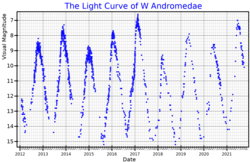| Observation data Epoch J2000 Equinox J2000 | |
|---|---|
| Constellation | Andromeda |
| Right ascension | 02h 17m 32.96122s [2] |
| Declination | +44° 18′ 17.7573″ [2] |
| Apparent magnitude (V) | 6.7 – 14.6 [3] |
| Characteristics | |
| Spectral type | S6,1e-S9,2e [3] |
| Variable type | Mira [3] |
| Astrometry | |
| Radial velocity (Rv) | −38.19±0.4 [4] km/s |
| Proper motion (μ) | RA: −0.162 [2] mas/yr Dec.: −2.516 [2] mas/yr |
| Parallax (π) | 2.2125±0.0953 mas [2] |
| Distance | 1,470 ± 60 ly (450 ± 20 pc) |
| Absolute magnitude (MV) | −5.27 [5] |
| Details | |
| Mass | 5.6 [6] M☉ |
| Luminosity | 8,394 [7] L☉ |
| Surface gravity (log g) | −0.61 [6] cgs |
| Temperature | 3,030 [6] K |
| Metallicity [Fe/H] | 0.003 [6] dex |
| Other designations | |
| HD 14028, BD+43 461a, HIP 10687, HR 663 | |
| Database references | |
| SIMBAD | data |
W Andromedae is a variable star in the constellation of Andromeda. It is classified as a Mira variable and S-type star, [8] and varies from an apparent visual magnitude of 14.6 at minimum brightness to a magnitude of 6.7 at maximum brightness, with a period of approximately 397.3 days. [3]
W Andromedae was discovered by Thomas David Anderson in 1899. [9]
W Andromedae is an S-type AGB star, [10] in the process of expelling its red giant envelope into space. Line emission from the 115 GHz rotational transition of carbon monoxide was detected in 1986 by Benjamin Zuckerman et al. The width of the emission line indicated that the star is surrounded by a circumstellar envelope expanding at 11 km/sec. [11] The star is losing mass due to stellar winds at a rate of 2.79×10−7 M☉/yr. [5]
